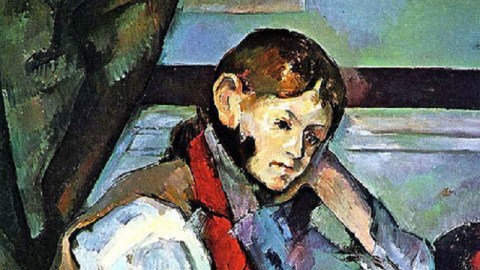Are the Rules of Stealing Art Changing?

Art news always offers wonderful confluences that stir the imagination. The wonderful news that Paul Cézanne’s The Boy in the Red Waistcoat (detail shown above), which had been stolen by armed gunmen in 2008 from a museum in Switzerland, had been recovered by police in Serbia was quickly followed by disturbing news of a new exhibition in London featuring and celebrating purloined pieces of art clipped from the artwork of modern masters such as Marcel Duchamp, Wassily Kandinsky, Joseph Beuys, Claes Oldenburg, and Robert Rauschenberg (plus modern art self-marketer Jeff Koons). Stealing a whole painting worth approximately $100 million—bad. Stealing fragments of art worth thousands, if not millions, collectively—good? As much as I can never imagine a scenario where the Cezanne theft becomes a form of art in of itself, I’m also having trouble seeing how secretively chipping away at a Duchamp and putting it on display is art. Are the rules of stealing art changing?
Brooklyn-based artists Eva and Franco Mattes, aka online as 0100101110101101.org, “appropriated” (their euphemism of choice for “stole”) tiny bits of art by these canonical modern artists between 1995 and 1997: a blob of lead from a Beuys installation, a bit of shoelace from an Oldenburg, and even a chip from one version of Duchamp’s porcelain Fountain, one of the most iconic pieces of Dada. These “hot” bits comprise the brazenly, but honestly titled work Stolen Pieces. Many of the other works at their first solo exhibition, titled Anonymous, Untitled, Dimensions Variable, at the Carroll/Fletcher Gallery in London, England through May 18th, follow the same larcenous theme: personal photos stolen from personal computers of other people, an Atari arcade game, and a recreation of a Gilbert and George performance. The artists, who also go by “artist-provocateurs,” waited until 2010 to reveal the “process” of Stolen Pieces to allow the statute of limitations to run out and avoid legal proceedings. Franco Mattes claims that that their actions were was “absolutely not vandalism,” but, instead, a strange kind of homage. “I thought it was the greatest tribute I could ever pay to these artists,” he explains.
I’ve written previously about Anna Watkins Fisher’s paper “We Are Parasites: On the Politics of Imposition,” that suggested that feminist art should use guerrilla tactics of a parasitic nature, similar to the art of Roisin Byrne, who turned shoplifted diamonds into art and even lifted pieces of Fisher’s thesis and published them as her own. Byrne steals and claims the work of others as her own because she sees herself as representative of the disadvantaged position of women in society. Forced to be the outsider, Byrne (and, by extension, all women artists) must steal because everything’s been stolen from her. Eva and Franco Mattes might want to claim a position of disadvantage as young artists overshadowed by Duchamp et al, but Franco’s “greatest tribute” quote cancels that. If they felt any anxiety of influence, they’re not telling.
So what does that leave us with? Hearing about Stolen Pieces genesis, I couldn’t help but think of one of my favorite quotes by T.S. Eliot. “Immature poets imitate; mature poets steal,” Eliot wrote in an essay about 17th century playwright Philip Massinger and Massinger’s liberal borrowings from Shakespeare. If Eliot stopped there, you might say the Mattes pair were just being “mature” artists stealing rather than going halfway through pale imitation. But Eliot goes further: “bad poets deface what they take, and good poets make it into something better, or at least something different.” I think these artist-provocateurs are “bad poets” because of how they’ve defaced the original works. “Better” is a matter of opinion, but I’d argue against Stolen Pieces being “something different.”
So what is Stolen Pieces if it’s not art, not parasitism, and not tribute? I’d suggest the best analogy is the relic—the cherished bits of saints’ bodies around which medieval pilgrimage sites were built. The Matteses may cherish their relics from the oeuvres of great artists, but, just like many relics from centuries ago, there’s something false about the fragments. A tow bone of a saint would, upon closer inspection, really be from a sow. Upon closer inspection, a chip from a Duchamp is not a Duchamp. When The Liberty Bell toured the United States in the 19th century, souvenir takers scraped away nearly 1% of the bell’s original weight. Those scraps of metal diminished the bell’s mass, but not it’s symbolic power, which remained with the bell itself. Likewise, the fragments of Stolen Pieces fail to capture the spirit of the original works or even a trace of it. Stolen Pieces does succeed in diminishing faith in modern art making. Mature artists steal ideas, themes, and techniques and transform them into something new and their own. The statute of limitations may have run out on legal options for questioning this act, but I hope that the court of public opinion will prosecute these artists to the fullest extent.
[Image:Paul Cézanne. The Boy in the Red Waistcoat (detail), 1888.]





